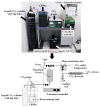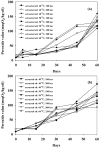Utilizing Supercritical CO2 for Bee Brood Oil Extraction and Analysis of Its Chemical Properties
- PMID: 39200413
- PMCID: PMC11354136
- DOI: 10.3390/foods13162486
Utilizing Supercritical CO2 for Bee Brood Oil Extraction and Analysis of Its Chemical Properties
Abstract
To obtain oil from bee brood, which was dried using a tray drying method, this study used the supercritical CO2 extraction method. Extraction occurred at temperatures between 40-60 °C and low pressures of 180-220 bar for 1.5 h, with a high pressure of 600 bar for 1 h. The study investigated both the yield and chemical properties of the extracted bee brood oils. Supercritical CO2 extraction of tray-dried bee brood at 600 bar pressure demonstrated higher oil extraction efficiency compared to lower pressures (180-220 bar). At temperatures of 40-60 °C, total phenolic compounds increased while total flavonoids decreased. The extracted oil exhibited antioxidant activity, primarily due to quercetin. Despite decreased acid, iodine, and saponification values, peroxide value slightly increased but remained below 12 meqO2/kg of oil. The make-up of the fatty acids changed. At 600 bar, palmitic and oleic acids were the most common, while myristic, linoleic, and docosadienoic acids decreased. At 600 bar, eicosadienoic acid was absent. The defatted bee brood retained significant essential and non-essential amino acids, indicating its potential for further development as a protein source.
Keywords: fatty acids; quercetin; supercritical CO2 extraction; total flavonoids; tray-dried bee brood.
Conflict of interest statement
The authors declare no conflicts of interest.
Figures


Similar articles
-
Supercritical extraction of sunflower oil: A central composite design for extraction variables.Food Chem. 2016 Feb 1;192:647-59. doi: 10.1016/j.foodchem.2015.07.070. Epub 2015 Jul 17. Food Chem. 2016. PMID: 26304395
-
Impact of Supercritical CO2 Treatment on Lupin Flour and Lupin Protein Isolates.Foods. 2025 Feb 17;14(4):675. doi: 10.3390/foods14040675. Foods. 2025. PMID: 40002118 Free PMC article.
-
Obtaining an Oily Ingredient Rich in PUFAS and Tocopherols and a High-Nutritional-Value Flour from Beans (Phaseolus vulgaris L.) by Supercritical CO2 Extraction.Foods. 2023 Dec 21;13(1):36. doi: 10.3390/foods13010036. Foods. 2023. PMID: 38201064 Free PMC article.
-
[Supercritical CO2 extraction of fatty oils from bee pollen and its GC-MS analysis].Zhong Yao Cai. 2004 Mar;27(3):177-80. Zhong Yao Cai. 2004. PMID: 15272780 Chinese.
-
Physicochemical and fatty acid profile of egusi oil from supercritical carbon dioxide extraction.Heliyon. 2018 Dec 31;5(1):e01083. doi: 10.1016/j.heliyon.2018.e01083. eCollection 2019 Jan. Heliyon. 2018. PMID: 30619961 Free PMC article.
References
-
- Camazine S. Self-organizing pattern formation on the combs of honey bee colonies. Behav. Ecol. Sociobiol. 1991;28:61–76. doi: 10.1007/BF00172140. - DOI
-
- Narumi S. Honeybee brood as a nutritional food. Honeybee Sci. 2004;25:119–124.
-
- Abd Al-Fattah M.A., Sorour M.A., El-Din E.O.N. Chemical composition of honeybee (Apis mellifera L.) brood. J. Agric. Sci. Mansoura Univ. 2009;34:5365–5371. doi: 10.21608/jppp.2009.188390. - DOI
-
- Finke M.D. Nutrient composition of bee brood and its potential as human food. Ecol. Food Nutr. 2005;44:257–270. doi: 10.1080/03670240500187278. - DOI
Grants and funding
LinkOut - more resources
Full Text Sources

